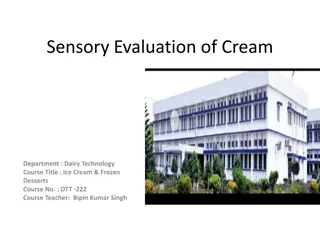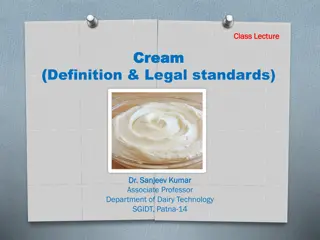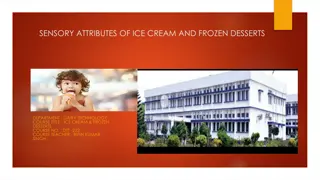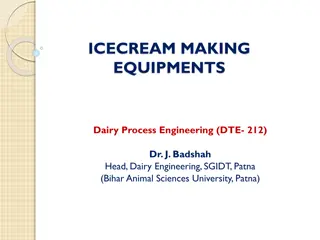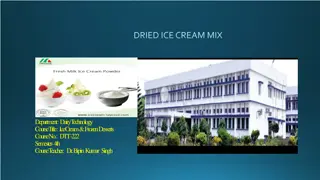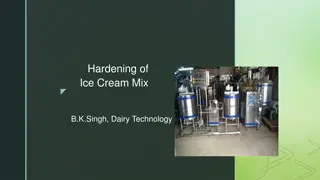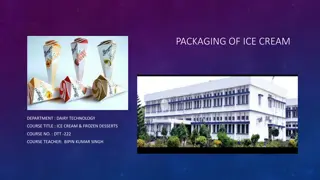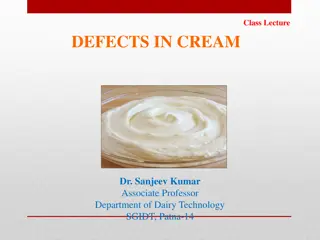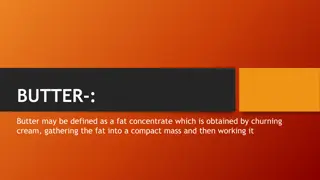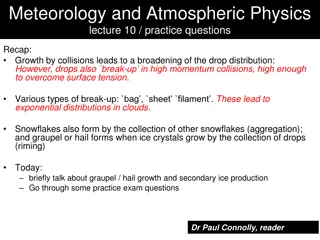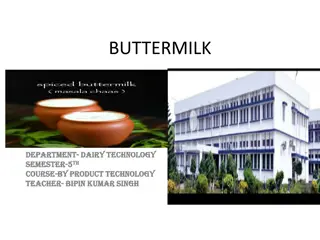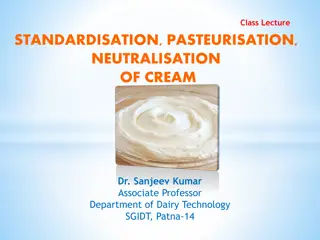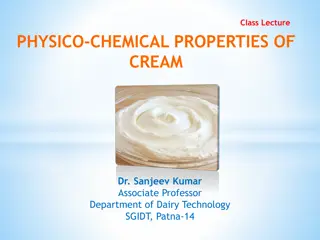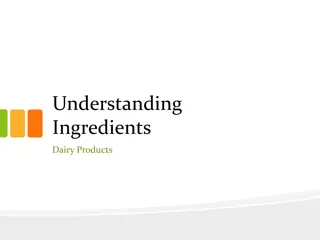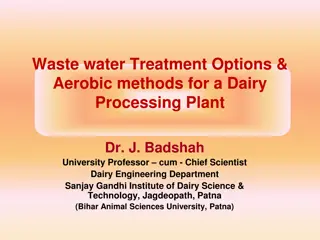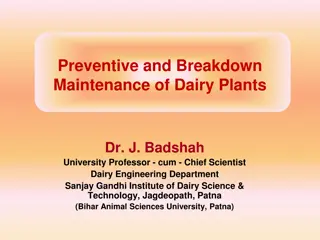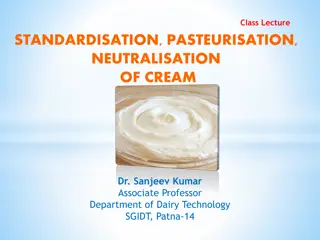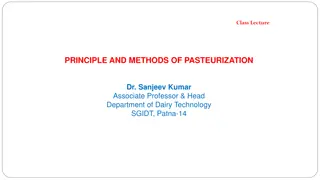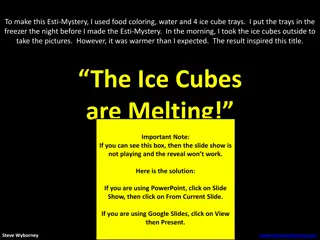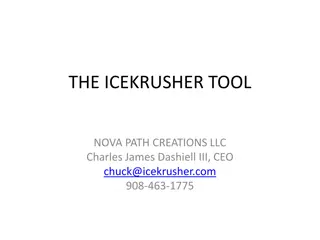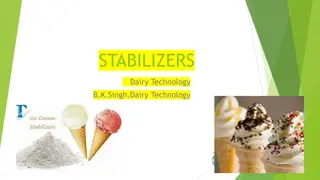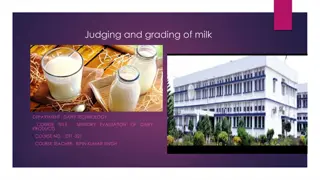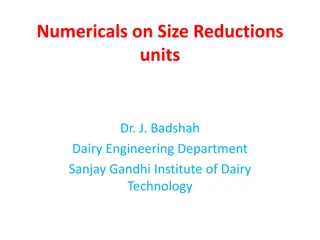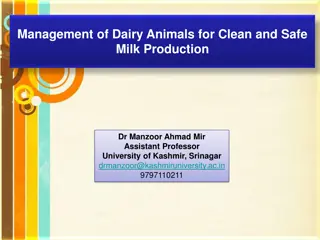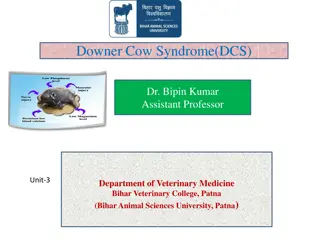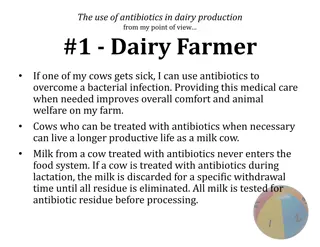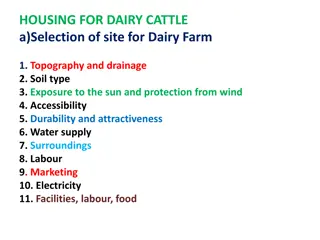Comprehensive Guide to Ice Cream Mix Preparation in Dairy Technology
Ice cream mix preparation is a crucial process involving selection of ingredients, formulation, blending, pasteurization, homogenization, cooling, and aging. Key components like dairy and non-dairy ingredients are carefully chosen to achieve the desired flavor, texture, and quality in the final ice cream product. Various methods such as Pearson square, serum point, formula tables, and computer formulations are employed to create a well-balanced mix meeting legal standards.
Download Presentation

Please find below an Image/Link to download the presentation.
The content on the website is provided AS IS for your information and personal use only. It may not be sold, licensed, or shared on other websites without obtaining consent from the author. Download presentation by click this link. If you encounter any issues during the download, it is possible that the publisher has removed the file from their server.
E N D
Presentation Transcript
PREPARATION OF ICE CREAM MIX DAIRY TECHNOLOGY B.K.SINGH, DAIRY TECHNOLOGY
ICE CREAM Ice cream is a complex product containing milk components like emulsified fat, protein in colloidal form and a solution of lactose and salts along with or without cane sugar, eggs, fruit juices, fruits, flavours, colours, stabilizers and emulsifiers.
PREPARATION OF ICE CREAM MIX Preparation of ice cream mix involves various essential steps viz. Selection of ingredients Formulation of ice cream mix Blending of mix Pasteurization of mix Homogenization of mix Cooling of mix Ageing of mix
SELECTION OF INGREDIENTS Selection of ingredients depends on their Availability Perishability Convenience in handling Effect on flavour, body and texture of ice cream Cost Equipments available etc
DAIRY INGREDIENTS Dairy products that supply fat and MSNF Sweet cream, Sweet milk, fresh butter, unsweetened, condensed and evaporated milks , full-cream milk powder, separated milk powder.
NON-DAIRY INGREDIENTS Sweetening agents Cane sugar, beet sugar, corn sugar, corn syrup, invert sugar,saccharin Stabilizers Gelatin, sodium alginate, guar gum, etc. Emulsifiers Mono or di-glycerides of fat forming fatty acids Flavours Vanilla, chocolate, strawberry, pineapple, lemon, banana, mango, orange, etc. Colours Yellow, green, pink, etc. Egg solids Yolk solids Fruits & nuts Apple, banana, mango, pine apple, grape, almond, pistachio, cashew nut, walnut and groundnut.
FORMULATIONS OF MIX The fundamental requirement of mix formulation is to obtain a well balanced mix which also satisfies The legal standards. A correct total solids to water ratio There is inverse relation between fat and SNF in ice cream mix A correct fat to sugar ratio
FORMULATIONS OF MIX The following methods can be used to calculate the mixes: Pearson square method Serum point method Formula tables / graphics method Algebraic method Computer developed formulations
STANDARDIZATION OF ICE CREAM MIX In order to attain the desired composition of ice cream mix, the calculated quantities of ingredients (dairy and non dairy) is obtained through standardization. This is accomplished using either (a) Algaebraic method, (b) Serum Point method In algebraic method the following three equations are used: Quantity equation(W+C+P=100-NDP) Fat equation (W F1+C F2+P F3=Desired fat % 100) SNF equation(W SNF1+C SNF2+P SNF3=Desired SNF% 100)
STANDARDIZATION OF ICE CREAM MIX W=Whole milk C=Cream P=SMP NDP=Non Dairy Product
BLENDING OF MIX The ingredients to be blended are taken in a vat, where it can be heated to facilitate dissolving, blending and pasteurizing. Mixing process varies from a small batch operation type to a large scale automatic continuous type depending upon the amount of mix to be processed. Liquid ingredients Dry ingredients. Sodium alginate Sugar Butter, plastic cream, frozen cream or other frozen products(melted form)
HOMOGENIZING MIX Homogenization of ice cream mix is a most essential step to make a permanent and uniform suspension of the fat by reducing the size of the fat droplets to a very small diameter, preferably not more than 2 m. never allow the fat to form the cream layer More uniform ice cream Smoother texture Improved whipping ability Shorter ageing period Less opportunity for churning to occur in freezer Less stabilizer is required
HOMOGENIZING MIX Homogenization of mix is usually done at temperature ranging from 63 to77 C. A pressure of 2000 to 2500 psi (135 to 170 kg/cm 2 ) with one valve or 2500 to 3000 psi (170 to 200 kg/cm 2 ) on the first and 500 psi(35 kg/cm 2 ) on the second stage will usually give good results for an average mix.
PASTEURIZATION OF MIX Pasteurization is done to destroy all the pathogenic bacteria in the mix so as to render the final product safe for human consumption Advantages of pasteurization are:- Renders the mix completely free of pathogenic bacteria. Dissolves and helps to blend the ingredients of the mix. Improves flavour. Improves keeping quality. Produces a more uniform product
COOLING OF MIX Mix should be rapidly cooled to a temperature below 4 C using a plate heat exchanger. Unless the mix is cooled to a temperature of 4 C or lower, it will become very viscous and the ice cream will not melt down smoothly. Also, temperatures below 5 C retard the growth of bacteria.
AGEING OF MIX Cooled mix is left to age preferably for a period of 24 h at 4 C. Changes that occurs during ageing are Hydration of milk proteins Crystallization of fats Absorption of water by any added hydrocolloids Viscosity is increased largely due to the previously mentioned changes. Ageing is substantially completed within 24 h and longer period should be avoided to control spoilage by psychrotrophs.
FLAVOUR ADDITION Among the flavouring substances that play an important part in frozen desserts are vanilla, chocolate, strawberry, pineapple, lemon, banana, mango, orange etc. Type and intensity of flavours are important characteristics in ice cream where delicate flavours are preferred to harsh flavours. Examples:- Vanilla True Vanilla Extract, Concentrated vanilla Extract, True vanilla powder, Vanilla paste Chocolate and Cocoa Chocolate liquor,Cocoa powder, chocolate blend etc.
COLOUR ADDITION Colours should correspond to the flavour. Harmless Edible Legally Permitted


